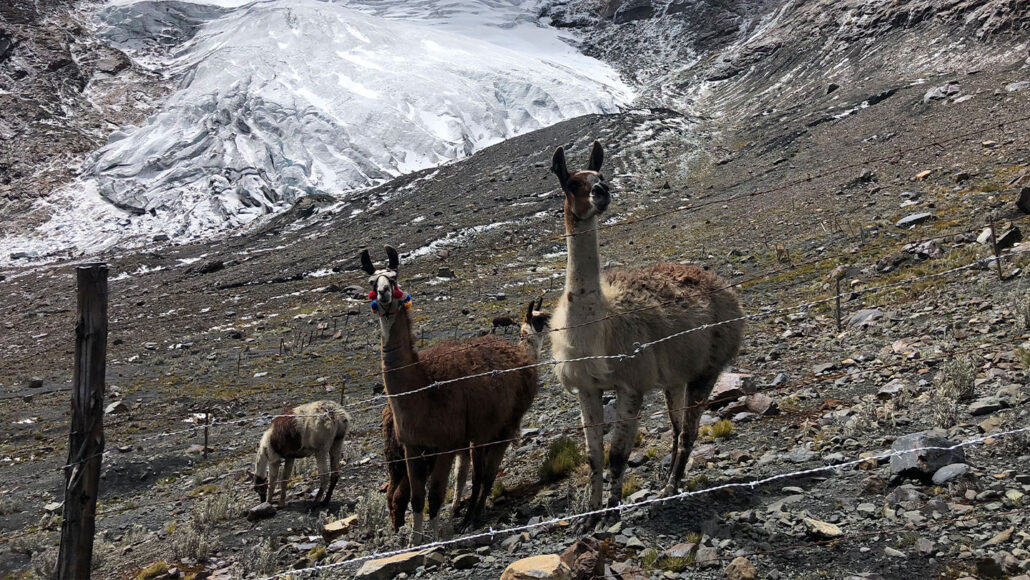Llamas' Contribution in Restoring Peruvian Land at the Base of a Melting Glacier

As glaciers recede, they often leave desolate landscapes that might take many years to repopulate with flora and fauna. However, recent research has shown that in just a three-year time span, these barren tracts of land can be regenerated by the activities of llamas. These animals enrich the soil and encourage plant growth with their activities.
In a project at the base of the shrinking Uruashraju glacier in Peru, scientists worked alongside local farmers to corral llamas into four select areas. Over the course of three years, from 2019 to 2022, the llamas (Llama glama) grazed in these zones, their droppings fertilizing the soil and dispersing viable plant seeds.
The results of this experiment, as reported by geographer Anaїs Zimmer and her team on September 24 in Scientific Reports, showed that the arid and erosion-prone soil regained stability and nutrient density, supporting a 57 percent increase in plant coverage in comparison to the pre-llama phase.
Zimmer, from the University of Texas at Austin, suggests that turning back to traditional Andean camelid herding practices could help protect local crops, wildlife and the livelihoods of local communities against the fallout from climate change.
Peru's Cordillera Blanca mountain range is witnessing a rapid shrinkage in glaciers, much like the rest of the world. With the receding ice, the surrounding ecosystems suffer, losing their summer water supply and sometimes dealing with damaging acidic minerals revealed by the departing glaciers.
The transformative effect of llamas on the land, evident in the study, can mitigate some of these negative effects. Llamas could potentially lessen the weathering of rocks and help the soil retain more water. This could decrease acidic runoff which can harm crops. Their grazing could lead to the creation of new pastureland as soil quality rises.
Previous studies have suggested that herbivore grazing can have beneficial impacts on landscapes, and various "rewilding" initiatives have aimed to reintroduce key species to their former habitats, like the reintroduction efforts for reindeer in Finland and plans in Spain to restore Aurochs. What surprised researchers in this study was how quickly and dramatically the llamas affected the landscape. From 2021 to 2022, average plant coverage in llama-grazed areas rose from around 9 percent to nearly 14 percent — quicker than the changes registered in four control regions. Four new plant varieties also appeared in the test areas during the study.
Ecologist Kelsey Reider, from James Madison University, who was not part of the study, comments that adding nutrients like phosphorus could potentially stimulate plant growth, but the llamas themselves make a significant contribution, especially through their feces, which hold moisture and microbes.
In the current study, the team chose llamas over the native vicuña, as the former are herdable and cause less damage. The area's farmers were also keen to restore llama numbers, partly for their role in Incan religious rituals. Llamas and other wild camelids were largely ousted by foreign livestock following Spanish conquests, which disrupted local flora. The farmers hope that bringing back the llamas could stymie or perhaps reverse this material and cultural erosion.
Zimmer would like to extend the study over ten years or more to assess the full impact of llama introduction. She acknowledges that while llamas might aid various plant species, it's unclear which ones will become dominant and whether they will impact the ecosystem positively or negatively.
Many communities revere the icy peaks, and the receding ice is seen as a loss of cultural identity. By the end of the century, scientists predict that Cordillera Blanca will lose the last of its glaciers due to global warming. If the contribution of llamas proves positive, Zimmer hopes local government bodies might consider investing in llama herding as an adaptive strategy. While it can't restore the glaciers, it could offer a degree of control to local communities.
Support for this article was provided by contributions from readers. Contribute today to help us provide quality science journalism.




